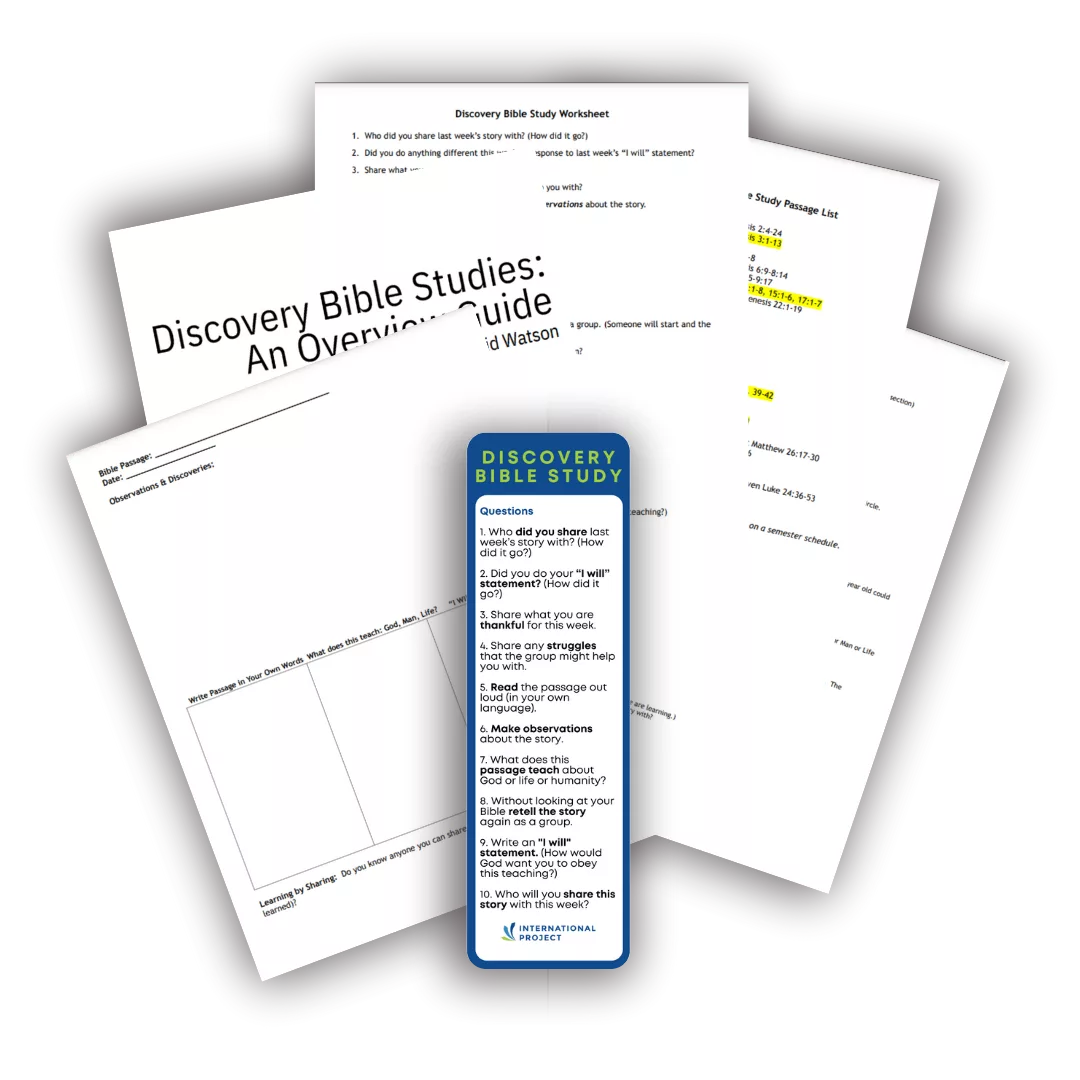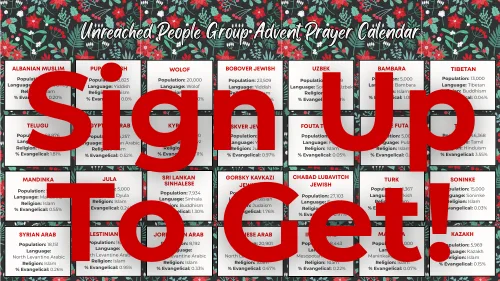Did you know that the Discovery Bible Study method can be a discipleship tool for non Christians? You may not have considered “discipling” someone to Christ, but it can be a powerful and effective way to help people discover Jesus through Scripture.
Beth,* a US based missionary, hosted a Discovery Bible Study (DBS) with several Nepali women in her neighborhood who didn’t know Christ.
Beth learned first hand that for non Christians from other religious backgrounds such as Islam or Hinduism, pre salvation discipleship is often the way they come to Christ.
You might think of discipleship as something that happens after a person becomes a believer, but with the Discovery Bible Study method, we are teaching participants elements of what it means to follow Jesus before they become believers.
In this way when they actually believe and commit to following Jesus, they already have DNA implanted within them about what it means to follow Jesus.
ln last week’s blog, we offered an overview of Discovery Bible Study and what makes it unique. This week, you’ll learn more about the Discovery Bible Study method, who it’s for, and its key questions.
What Is the Discovery Bible Study Method?
The Discovery Bible Study method is an interactive and easy to follow approach to reading and understanding God’s Word in a small group setting.
Here are the key steps of a Discovery Bible Study, assuming you’ve had an initial meeting:
- Begin by asking each group member: Who did you share the last story with? How did it go?
- Discuss the question: Did you do anything different in response to your previous “I will” statement?
Start here your first gathering:
- Share with each other what you are thankful for.
- Share any struggles that the group might help you with.
- Read the passage out loud (read in your own language).
- Make observations about the story.
- Without looking at your Bible, retell the story again as a group.
- Ask: What does this passage teach about God, life, and humanity?
- Make an “I will” statement. (Think: How would God want me to obey this teaching?)
- Ask one another: Who will you share this story with?
These questions guide you and your group to connect with God’s Word on a deeper level and allow the Holy Spirit to speak through the text.
Resist the temptation to skip questions #1, 2, 9, and 10! These are the keys to reproducing! If you skip this accountability, your discovery group becomes like any other Bible study or small group.
We do these steps to see a DBS transition into a church.
Let’s dig deeper into these questions and what makes the method so effective for studying the Bible with small groups of non Christians. But first, here’s what else you need to know.
How to Get the Most Out of the Discovery Bible Study Method
You can use the DBS method for both discipleship and evangelism for non Christians who have little or no knowledge of Scripture, but are spiritually curious.
For missionaries working in a cross cultural context, DBS helps transcend language and cultural barriers. DBS equips local believers to take ownership of their faith and naturally share it in ways that resonate with their communities.
In some contexts, facilitators will lead discovery groups instead of studies to help it appeal to a different demographic. For example, some in college ministry feel that students would rather participate in a discovery group than have more studies.
While you’ll want to pray over your study before and after you facilitate, we suggest you choose not to pray out loud during the group because you don’t want to shape their understanding of prayer with your cultural expression. However, others still pray during their studies.
Here’s what else you need to know.
Go at Their Pace
While Westerners may prefer to meet once a week, we can’t let our paradigms get in the way of ministering to those who are different than us. Sometimes you find a group who is so spiritually open that they want to meet more than once a week.
We want to go at the pace of the people in the group and that could even be daily. Occasionally we’ve had DBS groups request facilitators meet every day!
The Group Is the Method
Don’t do the Discovery Bible Study method with 1 person!
You want to gather a small group to study with.
We’ve tailored the DBS method for small groups of non believers to study together, facilitated initially by a follower of Jesus.
There are a few ways you can gather a group.
Ask a Spiritually Interested Person to Gather People
Our chief strategy here at International Project is that we encourage our workers to ask spiritually receptive people to gather a group of friends or family.
In other words, if you have a non Christian friend who expresses interest in studying the Bible with you, ask them to invite some of their friends to study together!
Working with internationals? If you facilitate an English conversation group, that’s a perfect type of small group from which a Discovery Bible Study can naturally develop. Participants already know each other and have become familiar with one another.
We’ve seen this model turn into church plants that become thriving house churches!
Recruit Your Own Group of Spiritually Interested People
It is not ideal, but you can do a Discovery Bible Study with a group of spiritually interested individuals from different cultures or people groups as well.
We usually only do this if we have several people who tried to gather but have been unable to. We never try this straight out. It is only a Plan B.
We strongly recommend not skipping the step to ask them to gather friends and family to study together.
Whether you’re planting churches or discipling new believers, DBS provides a culturally relevant, Scripture centered approach to guiding others in their faith journey to Christ.
Tips for Your First Meeting
Here’s a general script of how to introduce the Discovery Bible Study method:
Introduce the Method
- Thank you guys for letting me come into your community to help you learn the Word of God.
- Today, I’m going to show you a process of discovering what God is saying in His Word.
- When it comes to adult learning, we learn best when we incorporate many different parts of our body and life. When we study God’s Word, we will do the same: listening, reading, writing, discovering, repeating, responding, and sharing.
- Each week, we will follow the same simple process. I will facilitate this process for the first week or 2 and then others will facilitate this group after that. (See next section)
- This is a Discovery Bible Study. This means that we will discover as a group what God is saying to us in the Bible. There is NO teacher. The text will be our teacher. We will try to focus specifically on 1 text each time we meet. If you have a question, we will try to find the answer in the text we are discussing but if it is not there we will write it down so that we will look for the answer in future texts. (Remember that God is revealing Himself to us throughout a book and we will not fully understand God by just reading a few passages early in the book.)
Introduce the Bible
Here is a Bible. It is a collection of many books. God directed the authors to write His words.
- There are two major sections: Old Testament/and New Testament (For Muslims, these are also known as the Torah and the Injil, respectively). All the books written before the birth of Jesus are in the Old Testament. All the books written after the birth of Jesus are in the New Testament.
- If you look at the table of contents you will see the list of books and their page numbers.
- Each book is divided into chapters. The big numbers on the pages are the chapters.
- Each chapter is divided into verses. The small numbers are the verses. (So, if I say to look at Genesis 1:3, then you will turn to…( and then show them).
- Let us begin.
Hand off Facilitating
The believer is only supposed to facilitate for the first couple weeks and then hand over facilitation to one of the participants–even unbelievers!
If they are spiritual seekers, they will have the confidence to start a DBS with friends in another setting.
Next, let’s dig into the Discovery Bible Study method.
Discovery Bible Study Method: Step by Step
Now, let’s break down the DBS method to understand more about the 10 key steps.
1. Who Did You Share the Story with?
The first time you gather as a group, you won’t do steps 1 or 2.
But starting from the second meeting, your DBS group members will begin the session by holding each other accountable to ask who they retold the Bible story since the last meeting.
If someone doesn’t share, we will never shame or guilt them. All grace! Maybe we will say, “Ok, no problem, next time.” But every single time we will have this cadence of accountability.
2. How Did Your ‘I Will’ Statement Go?
Again, you won’t need this step the first time you meet.
From the second meeting and moving forward, encourage your DBS group members to share how they followed through on their obedience action step (otherwise known as your ‘I Will’ statement).
3. Share Joys and Praises
In this step, ask your group members to share things they are thankful for. This step paves the way for non Christians to notice the blessings in their lives and practice giving thanks to God.
The end goal of your DBS group is for non believers to find and accept Jesus as they read Truth in God’s Word.
The aim is that they will eventually develop into followers of Jesus who meet together as a house church. Sharing joys with one another builds into a gathering that regularly praises and worships together.
4. Share Challenges
In the same way that you share blessings in a DBS group, sharing struggles is also important. Make your DBS a safe, welcoming place where your people can speak honestly about their lives.
Begin by modeling that vulnerability is safe by sharing your own concerns.
Again, a DBS naturally transitions to a house church as participants come to discover God through studying the Bible together. Supporting fellow believers in hard times is something God calls all Christians to do!
Implant biblical DNA into your group by demonstrating that if someone is struggling, we are part of a community and we help each other.
5. Read Aloud Together
The DBS method uses a specific passage of Scripture each time from a carefully chosen Scripture list.
It takes people through the important points–from creation, fall, and redemption, to consummation. We even have a shortened list idea for studying during a college semester. (We will send you this list for free! Be sure to download your Discovery Bible Study method resources at the bottom!)
Note: Always have group members reading from exactly the same translation/version.
The focus is on the Word. We’re trying to build the DNA of scriptural authority.
6. Make Observations
After reading the story aloud, invite members to share their observations about the text. Ask people to share what they find curious, unusual, or encouraging. Let the Holy Spirit be the teacher.
We want them to make visible and plain observations. One facilitator shares, “Then I try to model this by making very simple, obvious observations that anyone could see. For example, In Genesis 1, I might make the observation that this is, ‘In the beginning.’”
If the believer starts by making a deep observation that is too theological and complex, then no one in the group will feel confident to make observations after that.
Remember, that you are only a facilitator, not an expert. Learn more about the philosophy behind a Discovery Bible Study here.
Because most participants will have little (if any) prior knowledge of the Bible, be prepared for some interesting observations!
For example, someone might compare the Bible to the holy book of their culture. Others might resonate with some of the ancient customs described (such as a familiarity with the concept of offering sacrifices).
Keep asking: Where do you see that observation in God’s Word? Where do you see that in Scripture?
7. Tell the Story
After you read the passage, ask participants to retell the story in their own words. This will help them get comfortable sharing the story with others.
When you intentionally practice telling the story without looking at your Bible, it helps you truly understand its meaning. Gently encourage and remind one another of details that they might be missing when they eventually retell the story.
Retelling the story also builds your confidence as you share these Bible stories with other people.
8. Ask the Big Questions about God and Humanity
Ask the group “What does this Scripture passage say about God?” This question helps you discover God’s heart, character, and actions as revealed in His Word. It displays God’s holiness, love, power, and mercy, helping participants grow in awe and worship.
The second big question is “What does this Scripture passage say about humanity?” This question reflects on human nature—our strengths, weaknesses, and need for God’s grace as human beings. It highlights examples of faith, obedience, or failure by people throughout Scripture to help you learn from them.
9. Make an ‘I Will’ Statement
Invite each participant to make an “I will” statement each time to help hold them accountable to obey God’s Word in practical and specific ways. Making an ‘I Will’ statement challenges participants to move beyond merely knowing Scripture to practically living it out.
Some examples of “I Will” statements are:
- I will choose to say kind things about others instead of gossiping
- I will nourish my body with healthy foods because it is God’s temple
- I will think about my blessings when I’m tempted to complain
Sharing these goals within the DBS group helps foster spiritual growth within a supportive small group community. Emphasize how God calls all of us to respond to his Truth.
This implants a DNA of obedience based discipleship (instead of a knowledge based discipleship.)
10. Who Will I Share This Story with?
This question encourages you and your group to retell what you’ve learned to others in your own words. Asking this builds in the DNA of evangelism before they become believers, even though we don’t use that word.
When you retell the Bible to friends, family, coworkers, or even new spiritually open people you meet, you reinforce your own understanding.
In the following gathering, the facilitator checks in to see how participants shared what they learned. These become steps 1 and 2 at the next Discovery Bible Study.
Remember the goal of DBS groups is to become house church communities as participants discover Jesus through studying His Word! Sharing and retelling Bible stories fosters a culture of disciple making.
We’ve just seen how impactful the Discovery Bible Study method questions can be. Now it’s your turn to start one of your own!
Want More?
What are you waiting for? Download your FREE Discovery Bible Study Questions PDFs today!
Our step by step Discovery Bible Study Questions PDF has 46 pages for you including:
- An overview of the DBS method and tips for using it in different cultures
- A Scripture list of story driven Bible passages leading from Creation to Christ
- Printable worksheets and bookmarks with the key DBS steps
- A facilitator’s guide to confidently guide your own Discovery Bible Study group
Just like Beth did with her Nepali neighbors, you can help your non Christian friends discover the Bible in a simple, yet powerful way.
The Discovery Bible Study method is a game changing tool for evangelism and discipleship in any ministry context!
Discovery Bible Study Questions PDFs
Sign Up For Discovery Bible Studies Now
We respect your privacy.🔒 Your email will only be used to send you how to access the Discovery Bible Studies and our related updates—unsubscribe anytime!

*Name changed for security


